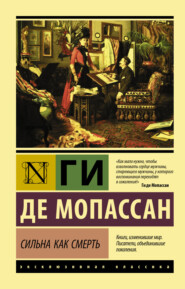По всем вопросам обращайтесь на: info@litportal.ru
(©) 2003-2024.
✖
Strong as Death
Настройки чтения
Размер шрифта
Высота строк
Поля
Bertin approached her, saying:
“You will disarrange my disorder.”
Without replying to this, she inquired:
“Who is the gentleman that wishes to buy your Baigneuses?”
“An American whom I do not know.”
“Have you come to an agreement about the Chanteuse des rues?”
“Yes. Ten thousand.”
“You did well. It was pretty, but not exceptional. Good-by, dear.”
She presented her cheek, which he brushed with a calm kiss; then she disappeared through the portieres, saying in an undertone:
“Friday – eight o’clock. I do not wish you to go with me to the door – you know that very well. Good-by!”
When she had gone he first lighted another cigarette, then he began to pace slowly to and fro in his studio. All the past of this liaison unrolled itself before him. He recalled all its details, now long remote, sought them and put them together, interested in this solitary pursuit of reminiscences.
It was at the moment when he had just risen like a star on the horizon of artistic Paris, when the painters were monopolizing the favor of the public, and had built up a quarter with magnificent dwellings, earned by a few strokes of the brush.
After his return from Rome, in 1864, he had lived for some years without success or renown; then suddenly, in 1868, he exhibited his Cleopatra, and in a few days was being praised to the skies by both critics and public.
In 1872, after the war, and after the death of Henri Regnault had made for all his brethren, a sort of pedestal of glory, a Jocaste a bold subject, classed Bertin among the daring, although his wisely original execution made him acceptable even to the Academicians. In 1873 his first medal placed him beyond competition with his Juive d’Alger, which he exhibited on his return from a trip to Africa, and a portrait of the Princesse de Salia, in 1874, made him considered by the fashionable world the first portrait painter of his day. From that time he became the favorite painter of Parisian women of that class, the most skilful and ingenious interpreter of their grace, their bearing, and their nature. In a few months all the distinguished women in Paris solicited the favor of being reproduced by his brush. He was hard to please, and made them pay well for that favor.
After he had become the rage, and was received everywhere as a man of the world he saw one day, at the Duchesse de Mortemain’s house, a young woman in deep mourning, who was just leaving as he entered, and who, in this chance meeting in a doorway, dazzled him with a charming vision of grace and elegance.
On inquiring her name, he learned that she was the Comtesse de Guilleroy, wife of a Normandy country squire, agriculturist and deputy; that she was in mourning for her husband’s father; and that she was very intellectual, greatly admired, and much sought after.
Struck by the apparition that had delighted his artist’s eye, he said:
“Ah, there is some one whose portrait I should paint willingly!”
This remark was repeated to the young Countess the next day; and that evening Bertin received a little blue-tinted note, delicately perfumed, in a small, regular handwriting, slanting a little from left to right, which said:
“MONSIEUR:
“The Duchesse de Mortemain, who has just left my house, has assured me that you would be disposed to make, from my poor face, one of your masterpieces. I would entrust it to you willingly if I were certain that you did not speak idly, and that you really see in me something that you could reproduce and idealize.
“Accept, Monsieur, my sincere regards.
“ANNE DE GUILLEROY.”
He answered this note, asking when he might present himself at the Countess’s house, and was very simply invited to breakfast on the following Monday.
It was on the first floor of a large and luxurious modern house in the Boulevard Malesherbes. Traversing a large salon with blue silk walls, framed in white and gold, the painter was shown into a sort of boudoir hung with tapestries of the last century, light and coquettish, those tapestries a la Watteau, with their dainty coloring and graceful figures, which seem to have been designed and executed by workmen dreaming of love.
He had just seated himself when the Countess appeared. She walked so lightly that he had not heard her coming through the next room, and was surprised when he saw her. She extended her hand in graceful welcome.
“And so it is true,” said she, “that you really wish to paint my portrait?”
“I shall be very happy to do so, Madame.”
Her close-fitting black gown made her look very slender and gave her a youthful appearance though a grave air, which was belied, however, by her smiling face, lighted up by her bright golden hair. The Count entered, leading by the hand a little six-year-old girl.
Madame de Guilleroy presented him, saying, “My husband.”
The Count was rather short, and wore no moustache; his cheeks were hollow, darkened under the skin by his close-shaven beard. He had somewhat the appearance of a priest or an actor; his hair was long and was tossed back carelessly; his manner was polished, and around the mouth two large circular lines extended from the cheeks to the chin, seeming to have been acquired from the habit of speaking in public.
He thanked the painter with a flourish of phrases that betrayed the orator. He had wished for a long time to have a portrait of his wife, and certainly he would have chosen M. Olivier Bertin, had he not feared a refusal, for he well knew that the painter was overwhelmed with orders.
It was arranged, then, with much ceremony on both sides, that the Count should accompany the Countess to the studio the next day. He asked, however, whether it would not be better to wait, because of the Countess’s deep mourning; but the painter declared that he wished to translate the first impression she had made upon him, and the striking contrast of her animated, delicate head, luminous under the golden hair, with the austere black of her garments.
She came, then, the following day, with her husband, and afterward with her daughter, whom the artist seated before a table covered with picture-books.
Olivier Bertin, following his usual custom, showed himself very reserved. Fashionable women made him a little uneasy, for he hardly knew them. He supposed them to be at once immoral and shallow, hypocritical and dangerous, futile and embarrassing. Among the women of the demi-monde he had had some passing adventures due to his renown, his lively wit, his elegant and athletic figure, and his dark and animated face. He preferred them, too; he liked their free ways and frank speech, accustomed as he was to the gay and easy manners of the studios and green-rooms he frequented. He went into the fashionable world for the glory of it, but his heart was not in it; he enjoyed it through his vanity, received congratulations and commissions, and played the gallant before charming ladies who flattered him, but never paid court to any. As he did not allow himself to indulge in daring pleasantries and spicy jests in their society, he thought them all prudes, and himself was considered as having good taste. Whenever one of them came to pose at his studio, he felt, in spite of any advances she might make to please him, that disparity of rank which prevents any real unity between artists and fashionable people, no matter how much they may be thrown together. Behind the smiles and the admiration which among women are always a little artificial, he felt the indefinable mental reserve of the being that judges itself of superior essence. This brought about in him an abnormal feeling of pride, which showed itself in a bearing of haughty respect, dissembling the vanity of the parvenu who is treated as an equal by princes and princesses, who owes to his talent the honor accorded to others by their birth. It was said of him with slight surprise: “He is really very well bred!” This surprise, although it flattered him, also wounded him, for it indicated a certain social barrier.
The admirable and ceremonious gravity of the painter a little annoyed Madame de Guilleroy, who could find nothing to say to this man, so cold, yet with a reputation for cleverness.
After settling her little daughter, she would come and sit in an armchair near the newly begun sketch, and tried, according to the artist’s recommendation, to give some expression to her physiognomy.
In the midst of the fourth sitting, he suddenly ceased painting and inquired:
“What amuses you more than anything else in life?”
She appeared somewhat embarrassed.
“Why, I hardly know. Why this question?”
“I need a happy thought in those eyes, and I have not seen it yet.”
“Well, try to make me talk; I like very much to chat.”
“Are you gay?”
“Very gay.”
“Well, then, let us chat, Madame.”
He had said “Let us chat, Madame,” in a very grave tone; then, resuming his painting, he touched upon a variety of subjects, seeking something on which their minds could meet. They began by exchanging observations on the people that both knew; then they talked of themselves – always the most agreeable and fascinating subject for a chat.
When they met again the next day they felt more at ease, and Bertin, noting that he pleased and amused her, began to relate some of the details of his artist life, allowing himself to give free scope to his reminiscences, in a fanciful way that was peculiar to him.
Accustomed to the dignified presence of the literary lights of the salons, the Countess was surprised by this almost wild gaiety, which said unusual things quite frankly, enlivening them with irony; and presently she began to answer in the same way, with a grace at once daring and delicate.
In a week’s time she had conquered and charmed him by her good humor, frankness, and simplicity. He had entirely forgotten his prejudices against fashionable women, and would willingly have declared that they alone had charm and fascination. As he painted, standing before his canvas, advancing and retreating, with the movements of a man fighting, he allowed his fancy to flow freely, as if he had known for a long time this pretty woman, blond and black, made of sunlight and mourning, seated before him, laughing and listening, answering him gaily with so much animation that she lost her pose every moment.

















